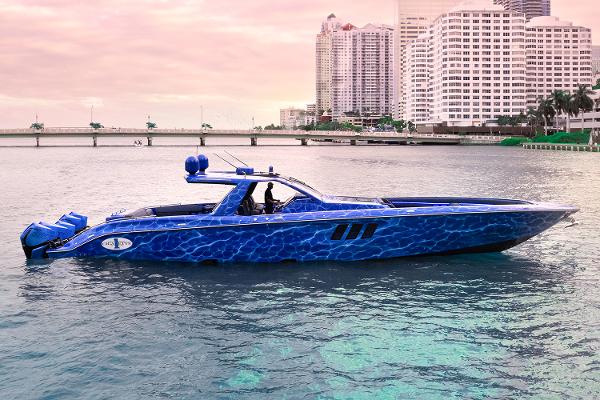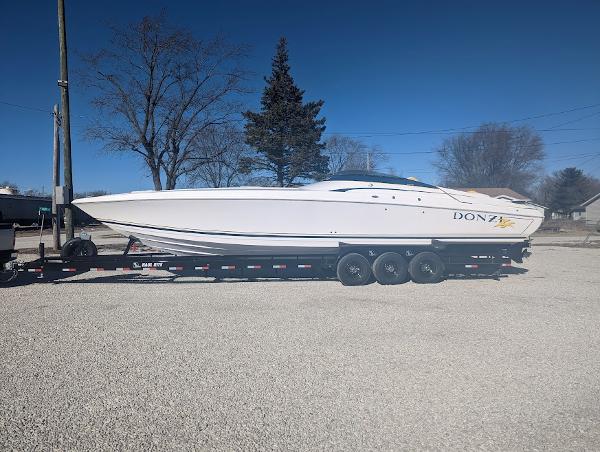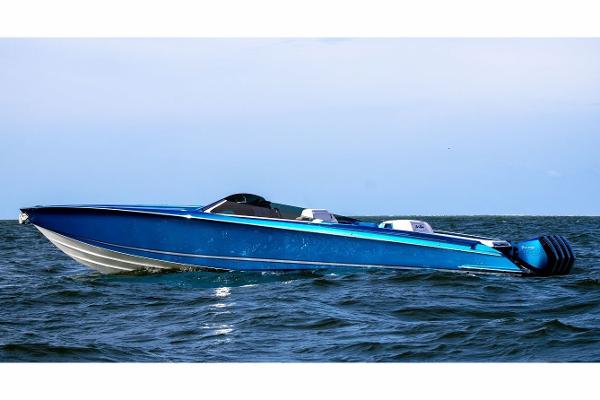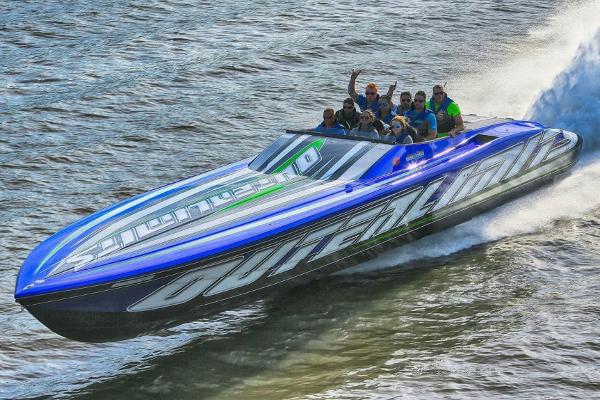Featured High Performance Brands
High performance boats for sale
-
Advertisement
-
Advertisement
-
Advertisement
-
-
Advertisement
Contact Seller
XHigh Performance
Ideal for day cruising and racing these High Performance boats vary in length from 13ft to 72ft and can carry 2 to 20 passengers. These powerboats use the following propulsion options: stern drive, high-horsepower outboard engines or inboards. There are a wide range of High Performance boats for sale from popular brands like Fountain, Cigarette and Baja with 555 new and 1,127 used and an average price of $90,145 with boats ranging from as little as $6,486 and $2,162,818.
High Performance Speed Boats Guide
There’s good news and bad news for newcomers to the high-performance powerboat and speed boat world. First, the bad. Nothing about go-fast boating is inexpensive—not the boats themselves, not the fuel for their engines, not the insurance and not, at least at the elite end of power and propulsion market, the maintenance. This is not an activity for the faint of wallet. No sense in sugarcoating it.
Now the good news: High-performance powerboating is an adrenaline-fueled blast. To some degree, open water beyond the no-wake and slow-speed zones is the last frontier for those with a need for speed. From sight to sound, the sensation of speed on the water is like no others
Far smaller than it once was, the core of the go-fast boat market has morphed into three currently popular categories: Performance-oriented V-bottom center consoles, sport catamarans and full-size go-fast catamarans and V-bottom sportboats. If you’re at all confused about the difference between a catamaran and a V-bottom, look at it this way: A V-bottom has one hull. A catamaran has two. Simple, right? At this point, that’s all you need to know. Now, let’s take a look at each category.

Performance center consoles are swift-moving social platforms. All photos by Pete Boden/Shoot 2 Thrill Pix.
Performance Center Consoles
You could argue with solid foundation and deep conviction that without the emergence of performance center consoles there would be no high-performance powerboat market. The recession of 2007-2008 devastated not just the production-built V-bottom sportboat segment, once the most popular choice for buyers thanks to economically attainable brand such as Baja, Donzi and Fountain. It hit the custom side of the industry hard.
Enter center consoles, primarily outboard engine-powered V-bottoms that take their name from the console/driving station in the center of their deck areas. That layout translates to lots of open space in front and behind the console itself, which makes center consoles ideal for fishing. And despite the introduction of Cigarette Racing 39 Top Fish in the early 2000s, the angling market was where center consoles stayed—at least until the recession forced former custom V-bottom and catamaran go-fast boat builders to look for products that could actually keep them in business.
As it was for fisherman, the inherent space in a center console layout gave rise to a new segment of the go-fast powerboat market. Performance center consoles are essentially social platforms that deliver a bit more spunk and spirit on the water than their angling-centric predecessors. As Mercury Marine and Mercury Racing have grown their successful Verado outboard engine line, the performance center console has grown—in sales volume as well as model size—with it. Custom builders who formerly produce nothing but dedicated go-fast boats began adding center consoles based on their existing, and in some cases brand-new, high-performance stepped hulls.
No longer called the 39 Top Fish, Cigarette’s 39-footer now has 41- and 42-foot siblings. Nor-Tech Hi-Performance Powerboats offers center consoles from 34 to 55 feet. Marine Technology, Inc., builds 42- and 57-foot center consoles. Mystic Powerboats has 38- and 42-foot models, and plans to expand its line in both directions. Reborn under the Iconic Marine Group, Fountain Powerboats is focused on center consoles and released a dazzling 39-footer—the company’s first new model in more than 20 years—at the 2018 Miami International Boat Show. Once exclusively a V-bottom sportboat builder, Sunsation Powerboats completely stopped sportboat production, and no longer offers them, when its 32- and 34-foot center consoles got hot.
Why would you want one? First, you’re a social creature with either a big family, lots of friends or both. Second, you crave a powerboat with a little performance attitude and appearance. Capable of running 80 MPH and beyond, performance center consoles do not look like fishing boats (most are built, in fact, without a single rod-holder). They typically have aggressive styling and sporty graphics.
Prices start in the high $300,000 range.

Sport catamarans are delighting go-fast boating newcomers and veterans.
Sport Catamarans
Twin outboard-powered models from 28 to 36 feet, sport catamarans are the current darlings of the go-fast powerboat world. Like performance center consoles, they owe much of their current success to the Verado outboard line, particularly the potent and reliable Mercury Racing 400R, which comes standard with a multi-year warranty and the option to extend factory protection.
Sport catamarans appeal to two groups of buyers at opposite ends of the boating experience spectrum. Novices appreciate their relative ease of operation, though driving lessons and a slow progression to top speed are essential for rookies, and reliability. As it happens, go-fast boating veterans also appreciate their reliability, as most have owned exotic and temperamental, at least on the inboard power side, full-size go fast cats. And with top speeds of 110 to 120 MPH, twin Verado 400R go-fast cats still offer enough juice to experienced buyers to be worth the squeeze.
Starting at $300,000 and going up from there, the options are many. DCB Performance Boats offers white-hot 28- and 33-foot sport catamarans. MTI has a sexy 34-footer as does fellow Midwestern outfit. Performance Boat Center and Wright Performance—PBC handles the rigging, interior and paintwork while Wright supplies the hulls—had an outstanding 36-footer. Skater Powerboats offers 28-, 31- and 36-footers—all works of art. Once imaginable given its pure V-bottom roots, Fountain Powerboats has even gotten into the game with a 32-footer sport cat.

For all out speed, full-size inboard-engine catamaran can’t be beat.
Full-Size Stern-Drive Cats and V-bottoms
If running 150 MPH and beyond is your goal, neither a performance center console or sport catamaran will get you there. And neither will be close to your ticket to ride in anything resembling rough-water at anything speed.
No, if you have industry people like to call the “speed gene” you’re going to need to look at full-size—38 feet and beyond—V-bottom sportboats and catamarans. And neither is suitable for novice operators. So buyer beware. In fact, buyer be very aware.
Let’s start with V-bottoms. Far less popular than they once were, they do offer tend to offer more spacious cabins than their catamaran counterparts. Whether they ride harder or softer in rough water than cats is the source of endless and pointless. Top speeds generally range from 100 to 145 MPH.

Full-size V-bottom sportboats still enjoy a loyal following.
For all intents and purposes, two companies—Cigarette Racing Team and Outerlimits Offshore Powerboats—still build custom V-bottom sportboats. Cigarette’s current models ran from 39 to 51 feet. Outerlimits current offerings range from 43 to 52 feet, and the company also offers 39- and 46-foot catamarans.
On the dedicated, longtime custom high-performance catamaran side there is Skater Powerboats, perhaps the best-known brand in the market segment, which builds full-size cats from 38 to 52 feet long. Fast doesn’t even being to describe—a 43-foot Skater cat with Mercury Racing dual-calibration 1550/1350 engines in 1,350 HP mode recently reached 180 MPH.
But there are great options beyond Skater, of course. MTI builds full-size cats from 38 to 52 feet. Mystic has 44- and 50-footers in its line. DCB Performance Boats just added a 44-footer, which is the company’s largest offering to date.
How much will you spend? Engine power and other options tend to dictate the final price, but you won’t touch anything new for less than $500,000 is this market segment.
Engines
Moving on from boat category, let's look at some other factors—first, engines. Obviously, this is a rather important feature in a speed boat. But remember that sheer power is not the end-all be-all item to consider. Reliability and longevity are two things that many speed boat buyers tend to disregard, at their peril.
Many speed boat engines are designed to run fast, run hard, and live a short life. That’s why most come with a very short warranty—usually no more than a year and/or 100 hours of operation, and sometimes as little as 10 hours of operation. As a boat buyer, obviously, you need to recognize the risk. If you’re buying new, remember that you may need to do major repairs or even replace a powerplant in just a year or two, and you need a financial plan that takes this into consideration—more than one speed boat has been purchased, used for a short period of time, then sat neglected because the owner didn’t want to or couldn’t afford to pay for a new engine. And if you’re buying a used speed boat, you’ll be well served by shelling out a few bucks to pay a marine mechanic to examine the powerplant (and drive unit(s), when applicable), prior to making a purchase.
Handling
In a speed boat, handling isn’t just a matter of convenience or pleasure; it’s a safety issue. At speeds of 60 or 70 MPH many boats can get a bit “squirrely” or chine-walk, which is an extremely dangerous situation. So just think of how much trouble you can be in if this happens while travelling at 100 MPH, 150 MPH, or even more.
The only way to tell how a high performance boat handles is to take it for a sea trial, period. Don’t believe what anyone else tells you because even if correct from one standpoint, it may not be correct about you, personally. An example: Bob is a highly-experienced driver who’s handled 150 MPH stepped-hull boats for dozens of hours of running time, and he finds the handling of a Speed Boat X perfectly acceptable. But Joe, who’s used to handling straight deep-V’s, may find Speed Boat X downright scary. You, personally, are a completely unique case. So before deciding if a boat is the right one for you, a sea trial is mandatory.
Versatility
Many speed boats are designed solely to go fast, with only a minimal crew. That may be fine for the die-hard race fanatic, but most of us want a boat with at least a little bit of versatility. And yes, there are plenty of choices out there. Those who want a cabin with a king-sized berth, air conditioning, and a full helm can look at boats like the Nor-Tech 420, which can run in the mid-70s with a pair of Mercury Racing 525 EFIs. If you enjoy wetting a line from time to time, you can look at boats like the Midnight Express 39 Open. Powered by a trio of Seven Marine 557 HP outboards, it’ll run you up into the upper 80’s but still has the flexibility and accouterments to go fishing when you like. Or for you guys who enjoy toting along a crowd for a ride—a really, really fast ride, that is—boats like the MTI 48, a 160 MPH cat that has no cabin but does sport cockpit bolster seating for six, should do the trick.

Modern outboards have helped create new classes of versatile speed boats.
Construction Quality
To attain those eye-watering speeds without shaking apart, speed boats need to be built strong—extremely strong. Most that hit triple digits are more than mere fiberglass, with Kevlar or carbon-fiber construction. But it’s tough (read: nearly impossible) to judge things like hull layup strength when you’re buying a boat. The best way to approach this issue is to do your research; look into a builder’s history closely, google the builder’s name along with search terms like “hull failure,” and if at all possible do a plant visit and see how the builder does things, first-hand.
Needs, desires and budget and should drive any would-be go-fast powerboat buyer’s purchase decision. And before you get started, you need to learn and define your terms.


































